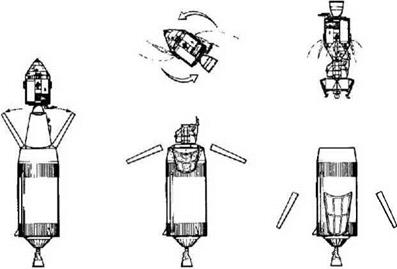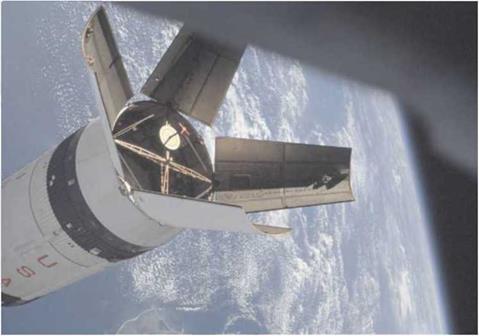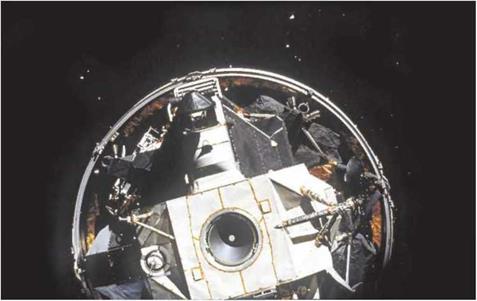TRANSPOSITION, DOCKING AND EXTRACTION Preparations
The first step in the whole process was to ensure that the command module’s cabin was pressurised up to its maximum extent, about two-fifths of an atmosphere. This was in preparation for when valves on each side of the tunnel that would eventually connect the two spacecraft would let oxygen flow from the CM into the LM, thereby saving the lunar module’s scarce resources.
While the crew7 worked through the TD&E checklist, the APS modules at the aft end of the S-IVB, which controlled the stack’s attitude, fired to bring it to the correct orientation for the manoeuvres. Planners had calculated the most appropriate attitude for the S-I VB to adopt to preclude the CMP being blinded, cither by the Sun or by reflections from the lander’s metal surfaces, yet give good illumination of a docking target mounted on the LM that was to aid the alignment of the two craft as the CSM came in to dock.
The CMP could monitor the whole manoeuvre using the entry monitor system (EM’S), an example of a piece of equipment that was meant for one purpose being
|
Diagram showing the major stages of the transposition, docking and extraction exercise. (NASA) " " " |
pressed into service for another. The EMS was a unit built into the main console that was to monitor the spacecraft’s re-entry into Earth’s atmosphere at the end of a mission. One of its displays was a digital readout that would, during a re-entry, show how many nautical miles they still had to travel before landing on the ocean. When the crew were performing a rendezvous, it could be switched to display how many feet separated the CM and an approaching LM. For powered manoeuvres, it could display how their speed changed in response to the thrust produced by the engines. This versatile unit could also send a shut-down command to the engines once a preset change in speed had been accomplished. Most of these functions were for later, but for TD&E, the command module pilot was interested in knowing how his speed, or to be more precise, his velocity had changed – a quantity known as delta-v.
In space flight, and in physics in general, an important distinction is made between speed and velocity. Speed simply defines distance travelled over a set time, and no account is taken of the direction of travel. With velocity, direction becomes part of the equation. In the three-dimensional arena of space, it is customary to measure speed after resolving it into three components of velocity. Therefore some frame of reference or coordinate system has to be brought into play where the directions of left/right, up/down and backwards/forwards are defined, usually labelled л’, у and z. As an example of how this works, an object whose velocity is three metres per second along the a axis and four metres per second along the у axis is actually travelling at five metres per second in a direction somewhere between these two axes by simple application of the Pythagoras Theorem. At this stage, it is worth noting that spaceflight is full of coordinate systems. The one used for velocity is different to that used for the spacecraft’s body.
Unlike the spacecraft’s main guidance system, which resolved delta-v in three axes, the EMS measured it along one axis only – in this case, along the spacecraft’s longitudinal axis – and displayed it on the digital readout in feet per second. It had its own accelerometer (a device that measured velocity changes), whose sensitive axis was aligned parallel to the spacecraft’s long axis. The dclta-v display could therefore be used by the CMP to monitor how thruster firings were affecting the spacecraft’s velocity as he separated from and then manoeuvred relative to the S-IVB. Before separation, he could zero the display, then directly read off how his velocity had altered with respect to the stage. However, pilots on the early missions had noticed that the della-v display did not work well around the zero mark, so they began to preset it to read minus 100 feet per second, which gave better results and was easier to interpret. A step was eventually included in the checklist to this effect.
Bang!
The precise time for the CSM to separate from the rest of the stack was not critical but. as was NASA’s nature, they defined it as part of their carefully organised flight plan. The major constraint to this whole exercise was that the S-IVB had to be left with enough battery power for the final manoeuvres which would steer it away from the spacecraft’s flight path and to its ultimate doom.
In the cabin, a one-hour event timer had been preset to read 59:30. It was then started 30 seconds before the planned moment of separation. Counting up, it reached zero at the intended moment of separation and it helped the crew to coordinate activities with their checklist both before and after the key moment. The timer was often used in this way for critical events in the mission.
With only two seconds remaining, the CMP, sat in the left couch, eased the translation control in his left hand forwards, away from himself. At his command, rear-facing thrusters on the service module began to fire so that, as soon as the CSM became free, it would move away from the SLA. The separation itself was executed by a guarded pushbutton on the main display console. This switch was one of a group of eight such buttons that could be used to initiate pyrotechnic events, but it was the only one that was meant to be used during a normal mission; the others allowed backup manual control of events that normally occurred automatically.
Separation was a fast yet complex event. An explosively driven guillotine severed the electrical connections between the spacecraft and the S-IVB. Next, a complex train of explosive cord was detonated to cut the service module free and to slice the uppermost three-quarters of the SLA into four separate panels. These panels were not allowed to immediately drift free of the stage. Rather, each had two partial hinges mounted along its lower edge. The pyrotechnics also forced small pistons mounted in the lower section of the SLA to push on the outside edges of the panels, ensuring that they rotated away as desired. Once the panels had swung away about 45 degrees, the hinges disengaged and the panels departed, pushed away from the S-IVB by springs built into the hinge mechanism. Each continued on its own path away from Earth; perhaps to impact the Moon, more likely to be east by the Moon’s gravity into some chaotic orbit around Earth and
|
Apollo 7’s S-IYB had no LM but included a target for docking practice. (NASA) |
then be deflected by the Moon into solar orbit, to interact with the Earth-Moon system every few decades. Today there are as many as 36 such panels out there. They will drift aimlessly for perhaps thousands of years. In the fullness of time, some may re-enter the Earth’s atmosphere and bum up, while others may be thrown into the deeper reaches of our solar system for eternity.
NASA did not originally intend to jettison the panels. During Apollo 7, the crew attempted a partial simulation of the TD&E manoeuvre for the first time. There was no LM occupying the SLA and partial hinges were not used for the panels, engineers having originally chosen to keep them attached. As the CSM returned to the S-IVB to manoeuvre near their mock docking target, the commander Wally Schirra observed how one of the panels had not properly deployed and was instead flexing uncomfortably close to where they intended to practise. His CMP Donn Eisele described the scene to mission control: “The SLA panel at the top, left and bottom are opened at [what] I would guess to be about a 45-degree angle, and the SLA panel on the right is just opened maybe 30 degrees at the very best.” Schirra elaborated: “Except for that one panel, everything looks like it’s just as you’d expect it to be on that S-IVB SLA deployment.” Schirra invoked the commander’s prerogative and cancelled the docking practice. He elected instead to station-keep with the S-IVB. “We’re a little worried to get backed up in there with that one cocked panel.” Next day, when they rendezvoused once again with the S-IVB, the panel was found to have fully deployed, but the practice approach was not attempted.
CSM turnaround
Having separated from the Saturn, the CMP continued thrusting forward, controlling with the translation hand control, until the EMS indicated that he had gained a speed of half a foot per second. Then, once enough time had elapsed to ensure that the CSM w as well clear of the third stage, he pulled back on the rotation control in his right hand. A different pattern of thrusters fired to pitch up the nose of the spacecraft for a half-turn that would point the CSM at the lunar module, now exposed atop the S-IVB.
One reason for using the EMS was because the crew could not see whether the spacecraft had cleared the third stage, and it was felt safer to rely on empirical measurement rather than guesswork. Not all the crews agreed with this approach. In his post-flight debrief. Richard Gordon of Apollo 12 felt the EMS got in the way. "If I’d been smart and used my head, I’d have taken these TD&E procedures and scratched all reference to the EMS whatsoever."
Both he and his commander Pete Conrad felt that it would have been enough simply to fire the thrusters for a set period of time, thereby simplifying the procedures. “That’s exaetly what 1 would have done," continued Gordon. "1 would have separated from the SLA. I‘d have thrust forward for the time to get 0.8 feet per second. I’d have counted to 15. and I would have backed off thrusting for a couple more seconds. And that’s all you need." An additional problem using the EMS was that it could not track the delta-v very well if the CSM was rotating, or was subjected to shock, both of which were happening in this task. Having set the display to read minus 100. Gordon found it had jumped to read minus 98 when he was expecting a reading over 100. "So I had no idea how much velocity I’d put in to the thing and I jusi continued thrusting forward for a few seconds, probably being conservative because I wanted to make sure I got far enough away from the booster before we did the turnaround."
On turnaround, many Apollo crews discovered that a lot of debris could be generated when the pyrotechnics fired to separate the CSM from the launch vehicle and cut the SLA into four. Even before America, Apollo 17‘s CSM, had turned around to face the LM Challenger. Ron Evans, exclaimed. “My gosh, look at that junk!"
By the time of this final Moon mission, the procedures for separation were well rehearsed. Evans let the CSM drift out for a few’ seconds. "Okay; there’s 15 seconds. Pitch her up.’’ As the spacecraft came around to view’ the S-IVB, Eugene Ccrnan spotted the debris surrounding it, “Houston, we’re right in the middle of a snowstorm."
“Roger." confirmed Capcom Bob Parker. “And we’d like Omni Delta." The rotation of the CSM meant that the omnidirectional antenna they had been using was no longer well placed and they needed to switch to another one to maintain a clear line of sight. Parker didn’t seem particularly interested in the debris.
"And there goes one of the SLA panels," called Cernan.
“Yes," agreed Evans as they continued rotating. “We’re not there yet. Longways to go yet."
“There goes another SLA panel, Houston, going the other way," said Ccrnan.
|
Apollo 15’s lunar module still nestled within the S-IYB and surrounded by a cloud of particles. On the left is the docking target. (NASA) |
Jack Schmitt had his own windows to look out of. "Hey, there’s the booster!” he yelled as the S-IVB came into view of his forward-facing window.
"Roger,” said Parker. "Bet you never saw the SLA panels on the simulator.”
Cernan agreed. "No, but we’ve got the booster and is she pretty! Challenger’s just sitting in her nest.”
"Roger. We’d like Omni Bravo, now, Jack,” requested Parker.
Cernan had been watching the particles that were floating outside his window. "And, Houston, some of the particles going by the window fairly obviously seem to be paint.”
Once the CSM had turned around to face the LM, its rotation was stopped. Then, by pushing on the translation controller, the CMP could kill the drift away from the third stage and start to approach. The LM’s docking port was on the roof of the lander, while the CSM’s was built into the apex of the command module. As the two spacecraft slowly came together, he had to keep them aligned. As an aid, he had an optical device, known as the crewman optical alignment sight (COAS), which was rather like a gun sight. It was mounted in the forward-facing window on the left and it gave him a consistent line of sight. A stand-off target was mounted on the LM, appropriately positioned so that the combination of the COAS and the docking target allowed him to adjust for left/right, up/down and angle of approach to bring the two spacecraft accurately together.
Ken Mattingly was surprised at how easy this manoeuvre proved to be – a testament to the fidelity of the simulations prior to the flight. "When we pitched over, the crosshairs on the COAS were almost exactly centred on the target. It was just a matter of pushing it, sitting there, and waiting for the two to come together. I made one lateral correction and one vertical correction. We didn’t do another thing until contact.”













